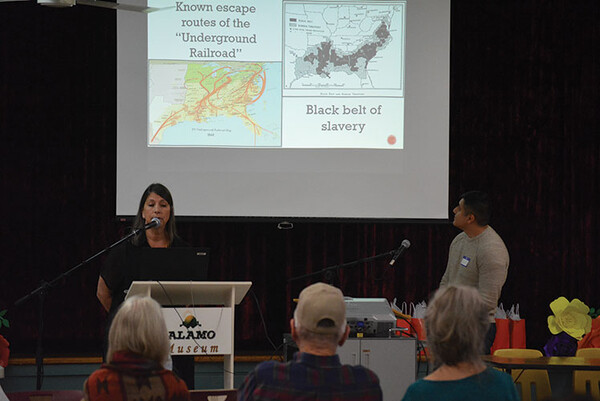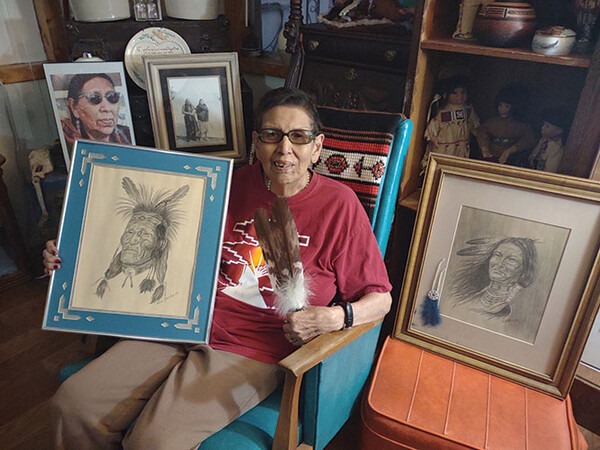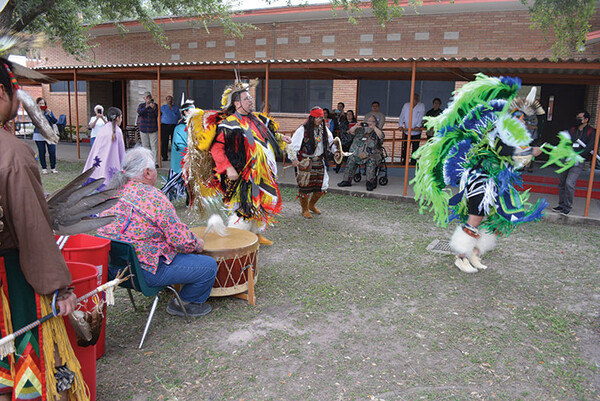 By Herb Moering
By Herb Moering
Winter Texans like to explore when in the “Valley” and one aspect they might not have considered is the landscape. In fact, some ancient landscapes still exist in South Texas according to University of Texas-Rio Grande Valley geology Professor Juan Gonzalez.
He pointed out several unique features of the RGV lands during the recent South Texas Historical Association (STHA) symposium hosted by the City of Alamo Museum.
One of those ancient landscapes, which are often invisible to most, is the Roma sandstone, which Gonzalez said was deposited 43 million years ago, when the Gulf shoreline was near Roma, Texas.
 The book Ancient Landscapes of South Texas Hiding in Plain Sight* says the exposed sandstone can be seen in the cliffs below Water Street in Roma and isolated outcrops elsewhere in the region. The Roma bluffs, a World Birding Center site, also provides a view of part of the Mexican border town of Ciudad Miguel Aleman and the international bridge.
The book Ancient Landscapes of South Texas Hiding in Plain Sight* says the exposed sandstone can be seen in the cliffs below Water Street in Roma and isolated outcrops elsewhere in the region. The Roma bluffs, a World Birding Center site, also provides a view of part of the Mexican border town of Ciudad Miguel Aleman and the international bridge.
Not too far away from Roma in Starr and Zapata counties are ancient beaches of fossilized oyster beds, related Gonzalez, who is one of authors of the book that was created as part of the Community Historical Archeology Project with Schools (CHAPS). The oysters were in an ancient intertidal lagoon. The fossil giant oyster shells provided the raw material for the manufacture of lime 100 years ago to make mortar and plaster for houses constructed with Roma sandstone blocks. Beds of broken shells are exposed on the shores of Falcon Lake State Park when the lake level is low.
It is believed, and evidence supports, a petrified forest existed near the town of Escobares, where in the early 1900s many fossilized tree trunks were taken by private collectors for landscaping purposes. Long before that, Native Americans used the petrified wood for projectile points and other tools.
The best example can be found in Roma at the intersection of Zaragoza Avenue and Grant Street on the eastbound lane of US Highway 83. The house fence has standing trees of up to 10 feet. The exterior wall of Our Lady of Refuge Catholic Church in Roma used petrified wood for construction. In Rio Grande City the Lady of Lourdes Grotto was built with petrified wood.
Gonzalez also mentioned the South Texas Sand Sheet located halfway between the Nueces and Rio Grande Rivers from the inland shore of Laguna Madre to 62 miles inland covering portions of five counties including Hidalgo, Willacy, Brooks, Kenedy and Jim Hogg. It was once home to an estimated million wild horses in the early 1800s.
 Another interesting part of the Valley landscape is La Sal Del Rey. La Sal Del Ray is one of three salt lakes that is part of the Lower Rio Grande Valley National Wildlife Refuge. It is without an inlet or outlet, but fills with runoff from heavy rains that gradually evaporates each summer forming a salt layer crust.
Another interesting part of the Valley landscape is La Sal Del Rey. La Sal Del Ray is one of three salt lakes that is part of the Lower Rio Grande Valley National Wildlife Refuge. It is without an inlet or outlet, but fills with runoff from heavy rains that gradually evaporates each summer forming a salt layer crust.
Gonzalez also discussed the hand-dug water wells needed first by the Spanish settlers. Later the rancheros dug them in the early 19th Century to make cattle ranching possible. Remnants of some of the 30-foot-deep wells are found in northern Hidalgo and southern Starr Counties. The best preserved is located on Old San Isidro Road for visitors to see.
Two final very old objects mentioned were the estimated 4.5-billion-year-old La Villa meteorite of nearly 44 pounds found by a farmer plowing his field, which now resides at the UTRGV planetarium in Edinburg, where it can be seen by the public; and Old Monty, considered the oldest living organism in the RGV at 900 years old. The Montezuma Cypress tree normally is along a riverbank, but Old Monty is in a farm field about a mile from the Rio Grande River due to shifting river channels.
The symposium also included lectures on the “Alamo Roots,” stretching back 400 years of Spanish grant migration, for Brownsville Schools CISD architect Manuel Hinojosa’s family; following two mixed-race couples and their families was the focus on “Pathways to Freedom” before the Civil War by UTRGV Professor Roseanne Bacha-Garza, and the hard life of sharecroppers in the first half of the 20th Century by STHA President Carroll Scogin Brincefield.
Native Americans also figured prominently in the presentations along with an exhibit of Indian art created by Nora Marston, of the Pawnee and Arikara tribes, now living in Alamo. She began drawing seriously in the late 1970s when she was in her mid-40s. Her artistry included a number of different articles made for her children and other family members, as she followed in her mother’s talented footsteps.
Among the speakers were Enrique Gonzalez, of Alamo, covering the Karankawa Indians and Dr. Robert Soto, vice chairman of the Lipan Apaches from McAllen, who explained their history, which is one of 10 Apache tribes. Soto also led the closing powwow ceremony.
*The book Ancient Landscapes of South Texas is available at the bookstore on the UTRGV campus in Edinburg.













